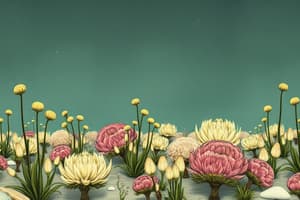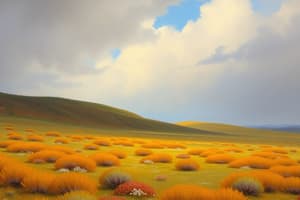Podcast
Questions and Answers
Which of the following is NOT a type of tundra mentioned in the text?
Which of the following is NOT a type of tundra mentioned in the text?
- Alpine tundra
- Desert tundra (correct)
- Arctic tundra
- Antarctic tundra
The Arctic tundra is a vast area frozen for much of the year. Only plants such as moss, heath, and ______ can grow on the bare land.
The Arctic tundra is a vast area frozen for much of the year. Only plants such as moss, heath, and ______ can grow on the bare land.
lichen
What is the main reason why no trees grow in the alpine tundra?
What is the main reason why no trees grow in the alpine tundra?
- The altitude is too high for tree growth (correct)
- The soil is unsuitable for tree growth
- The animals in the alpine tundra prevent tree growth
- The temperature is too cold for tree growth
What is the main reason why no trees grow in the alpine tundra?
What is the main reason why no trees grow in the alpine tundra?
The Antarctic tundra is too ______ and dry to support vegetation.
The Antarctic tundra is too ______ and dry to support vegetation.
Which animal is NOT commonly found in the Arctic tundra?
Which animal is NOT commonly found in the Arctic tundra?
Most alpine tundra animals are warm-blooded, and include marmots, mountain goats, chinchillas, pikas, and the kea parrots of ______.
Most alpine tundra animals are warm-blooded, and include marmots, mountain goats, chinchillas, pikas, and the kea parrots of ______.
What is the primary reason why the Antarctic tundra lacks large mammals?
What is the primary reason why the Antarctic tundra lacks large mammals?
Which of the following animals is NOT found in the Arctic tundra?
Which of the following animals is NOT found in the Arctic tundra?
Flashcards are hidden until you start studying
Study Notes
Studying That Suits You
Use AI to generate personalized quizzes and flashcards to suit your learning preferences.




